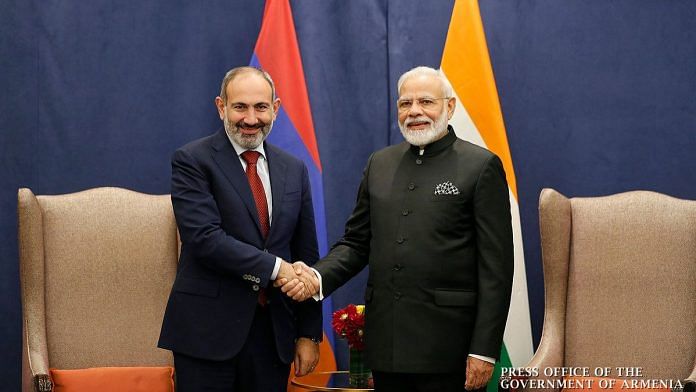Traditionally, India’s diplomatic focus has remained closer to home—first on its immediate neighbourhood, and then eastward via the Look East and Act East policies. A marked change came after the 2015 Security and Growth for All in the Region (SAGAR) doctrine, with India’s maritime vision taking centre stage in New Delhi’s strategic calculus.
Over the course of the current dispensation, New Delhi has broadened its strategic outreach way beyond the immediate theatres. With aspirations for a larger role in both geopolitics and geo-economics, India has begun to engage with new regions—seizing opportunities presented by the constant flux of global power dynamics.
India’s relationship with Armenia is a prime example of this shift. Long known as the world’s largest arms importer, and often struggling to modernise its indigenous defence sector, India found in Armenia a rare partner—one willing to procure nearly every major weapon system developed domestically.
As Russia—Armenia’s formal ally through the Collective Security Treaty Organization (CSTO)—failed to extend meaningful security guarantees during the Nagorno-Karabakh conflicts in 2020 and 2023, while simultaneously arming Azerbaijan, a was forced to look elsewhere for support. Russia’s deepening entanglement in Ukraine further diverted its attention from its traditional sphere of influence, leaving a vacuum that India stepped into with both urgency and strategic foresight.
While eager to modernise its defence capabilities, Armenia lacked the financial means to procure costly Western platforms. Its nascent defence industry was not yet equipped enough, just beginning to specialise in niche technologies. In a pragmatic move, Armenia turned to India.
Indian weapon systems, though not as expensive as their Western counterparts, offered reliable and effective solutions. Within just two years, by 2023, India had appointed a Defence Attaché to Yerevan and concluded multiple defence agreements worth millions of dollars. These covered a wide spectrum of indigenous platforms, from the Akash surface-to-air (SAM) missile systems and SWATHI weapon-locating radars to the advanced towed artillery gun system (ATAGS) and large consignments of ammunition. The only notable exception has been the BrahMos missile system—co-developed with Russia—which Yerevan has so far avoided, likely due to a strained relationship with Russia and Moscow’s closeness to Baku.
Armenia’s growing reliance on Indian defence exports marked a significant milestone for India. Historically, Indian weapons have struggled to gain recognition abroad, and cases like the grounded —despite discounted sales—have not inspired much confidence. However, Yerevan has not only bought several Indian platforms, but has also closely observed the performance of India’s indigenous systems in combat scenarios in the wake of Operation Sindoor strikes on Pakistani terror camps and air bases, bolstering confidence in their reliability.
India’s defence exports have surged in recent years, hitting the mark for the first time in 2024. With ambitions to surpass Rs 50,000 crore by the end of the decade, this trajectory appears within reach. However, a majority of these exports consist of dual-use technologies and secondary components destined for Western partners like the US and France. Armenia stands out as one of the few, perhaps the only country procuring full-fledged Indian platforms. A notable exception, though, is select Southeast Asian buyers of the Russian co-produced BrahMos missile, such as the Philippines and Vietnam.
Armenia then occupies a unique place in India’s defence outreach. For instance, the French had expressed interest in India’s Pinaka multi-barrel rocket launchers—spurred by India’s sale of the same to Armenia—though they ultimately opted for different systems. Nonetheless, such visibility in theatres of mutual interest provides a smart sales pitch to Indian defence prowess.
As the Armenia-Azerbaijan conflict currently lies in a fragile truce, and peace negotiations continue, now is the time for India to mature its defence partnership with Armenia—building resilience and establishing India as a reliable long-term partner. Several strategic avenues lie ahead: continuing direct weapons sales; integrating Armenian start-ups into “Make in India” and “Make for the World” initiatives; and cooperating within broader security frameworks.
One such avenue is the trilateral cooperation mechanism. While India is Armenia’s largest defence supplier, France holds the second position. Given India and France’s robust defence ties and a shared industrial roadmap, co-producing and co-exporting to third countries could be a mutual win. Beyond France, Armenia’s growing defence ties with Greece and Cyprus—especially following their 2024 —indicate a broader alignment aimed at counterbalancing Turkish and Pakistani influence in the region.
In the evolving geopolitical landscape of the Caucasus, there is growing potential for deeper cooperation between India, France, and Greece to support Armenia’s security architecture. For India, the key lies in transitioning from a transactional approach—centered on arms sales—to a more mature framework that ensures its rapidly expanding military footprint in the region is not only sustained but institutionalised. The prudent course for New Delhi then is to pursue long-term engagement as a credible security partner through joint exercises and coordinated activities with like-minded players.
Although defence cooperation is indeed the most visible symbol of India’s presence in the region, there is more beneath the surface.
At present, Armenia is navigating complex negotiations for a peace agreement with its neighbours. For a landlocked country encircled by adversarial powers—Azerbaijan and Turkey—and a disengaged Russia, survival depends on leveraging its geography. Armenia’s evolving strategy is to position itself as a vital connectivity hub for regional corridors. What may appear as a compromise today could, in fact, become a long-term stabilisation model for this nation of just three million people with strong nationalist sentiment.
From India’s perspective, the stakes are both economic and strategic. The International North-South Transport Corridor (), which begins in Mumbai and extends through Iran’s Bandar Abbas to the Persian Gulf, continues northward through Baku en route to Moscow. India has also been pushing for connecting INSTC to another Iranian port, Chabahar, which has significant Indian investments.
This corridor stands to gain significantly from new trade links that include Armenia.
India and Iran, in cooperation with Armenia, have been promoting this under a trilateral framework. Specifically, connectivity through Armenia’s southern Syunik province not only enhances regional trade dynamics but also offers India a counterweight to the growing Turkey-Azerbaijan axis in the Caucasus.
Armenia, already a reliable buyer of Indian defence platforms, is increasingly poised to serve as India’s strategic gateway into the South Caucasus. From there, India can diversify westward through Georgia into the Black Sea and Europe, or eastward into Central Asia and the Caspian basin. This vision, while ambitious, aligns with India’s growing infrastructure footprint along the broader Mediterranean arc.
Take, for example, India’s interest in connecting the India-Middle East-Europe Economic Corridor (IMEC) with the Three Seas Initiative—linking Eastern European, Baltic, and Adriatic markets. With the capability to develop port and transport infrastructure across critical maritime zones, India is uniquely positioned to counterbalance not only China’s influence in Central Asia but also Turkey’s growing dominance in the Caucasus. Importantly, if played intelligently, India’s long-standing ties with Russia could act as a facilitator, not an obstacle, to these ambitions.
Whether this interconnected vision eventually extends to include the Arctic—where geopolitical competition and contestation will intensify as ice caps recede—remains to be seen. But the trajectory is clear: India is readying itself for a broader, bolder role in the regions shaping tomorrow’s geopolitics through symbiotic relationships.
(Edited by Ratan Priya)








